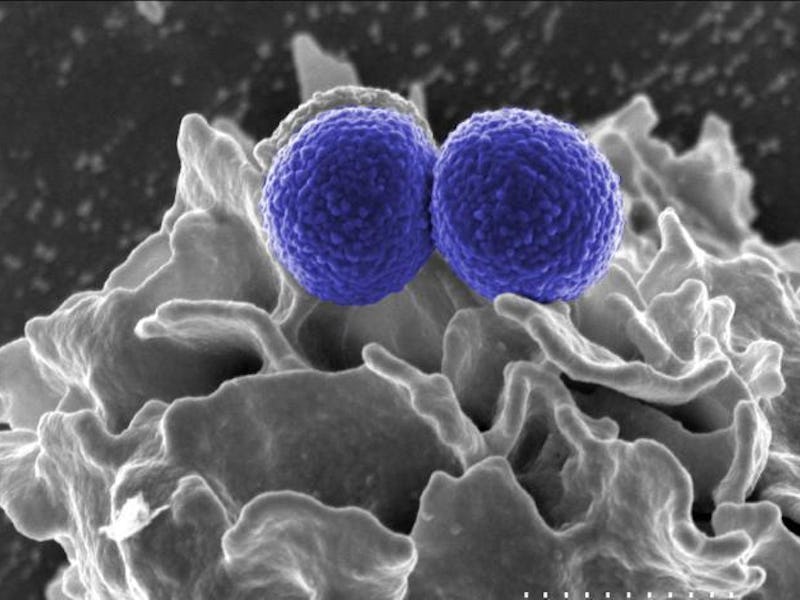New Drug Could Treat Superbugs Without Fostering Resistance
This could be a new weapon in the fight against hospital-acquired infections.

Most people go to the hospital expecting to get better. It’s a pretty reasonable expectation, right? Well, some unfortunate patients emerge from hospital visits with serious infections. Hospital-acquired infections are often caused by familiar strains of bacteria — like E. coli and Staphylococcus — that have developed over time to become immune to the antibiotics that used to kill them. These hospital superbugs are a growing concern in healthcare. A 2016 report estimated that drug-resistant superbugs could kill 10 million people per year by 2050.
But research published this week suggests that we may have a new weapon with which to fight them.
This is a big deal because our typical arsenal of antibiotics, each of which takes millions of dollars and a few years to produce, is quickly becoming ineffective against infections. One particular bacterium, methicillin-resistant Staphylococcus aureus, is resistant to methicillin, amoxicillin, penicillin, vancomycin, linezolid, daptomycin, and oxacillin — just to name a few. MRSA is a common culprit in hospital-acquired infections, and though hospital cleanliness procedures have helped bring the number of MRSA cases down dramatically, tens of thousands of people still contract it each year. It usually causes a minor skin infection, but it can also lead to sepsis, pneumonia, and bloodstream infections. In people with weakened immune systems, like elderly patients or those recovering from surgery, it can be fatal.
A team of researchers in India has found that a fatty acid comprising a particular amino acid combination can kill MRSA in mice. Mohini M. Konai and Jayanta Haldar of the Jawaharlal Nehru Centre for Advanced Scientific Research in Karnataka, India published their findings this Wednesday in the journal Bioconjugate Chemistry.
The scientists infected mice with MRSA, and applied a fatty acid called d-lysine conjugated tetradecanoyl analogue — affectionately known as D-LANA-14 — to the infections. They reached two important conclusions.
First, D-LANA-14 killed the MRSA without hurting the mice.
D-LANA-14 can treat MRSA infections in mice without hurting the mice or developing resistance. This is an important preliminary finding.
“Normal fur growth of the treated group of mice clearly indicated the nontoxic nature of D-LANA-14,” write the researchers.
This is a big deal because last-resort antibiotics are often pretty heavy duty, causing kidney, liver, and nervous system side effects, among others.
Second, the mice’s MRSA infections did not become resistant to the compound, even after many applications. This differs from the typical results obtained when using fusidic acid, one of the common treatments for MRSA, which quickly loses its effectiveness against the bacterium. The scientists say the key here is the chemicals’ methods of action.
“These results indicate that MRSA strains find difficulty in acquiring resistance against this class of membrane targeting compounds, but rapidly develop resistance against the protein synthesis targeting antibiotic fusidic acid,” write the researchers.
In other words, because D-LANA-14 targets MRSA’s membranes, and not the bacterium’s protein synthesis processes, the microbe has a harder time developing resistance. Further research should indicate why this is the case.
While this is just a preliminary finding in mice, it’s promising that these researchers have found an existing compound that treats MRSA infections without hurting the test subjects or fostering antibiotic resistance. Hopefully, D-LANA-14 can become an effective weapon in the fight against hospital superbugs — and maybe we can come up with a snappier name for it, too.
Abstract: Methicillin-resistant Staphylococcus aureus (MRSA) has developed resistance to antibiotics of last resort such as vancomycin, linezolid, and daptomycin. Additionally, their biofilm forming capability has set an alarming situation in the treatment of bacterial infections. Herein we report the potency of fatty acid comprising lysine conjugates as novel anti-MRSA agents, which were not only capable of killing growing planktonic MRSA at low concentration (MIC = 3.1–6.3 μg/mL), but also displayed potent activity against nondividing stationary phase cells. Furthermore, the conjugates eradicated established biofilms of MRSA. The bactericidal activity of d-lysine conjugated tetradecanoyl analogue (D-LANA-14) is attributed to its membrane disruption against these metabolically distinct cells. In a mouse model of superficial skin infection, D-LANA-14 displayed potent in vivo anti-MRSA activity (2.7 and 3.9 Log reduction at 20 mg/kg and 40 mg/kg, respectively) without showing any skin toxicity even at 200 mg/kg of the compound exposure. Additionally, MRSA could not develop resistance against D-LANA-14 even after 18 subsequent passages, whereas the topical anti-MRSA antibiotic fusidic acid succumbed to rapid resistance development. Collectively, the results suggested that this new class of membrane targeting conjugates bear immense potential to treat MRSA infections over conventional antibiotic therapy.